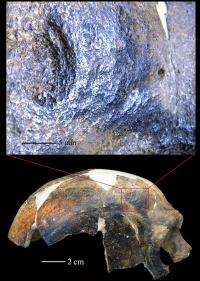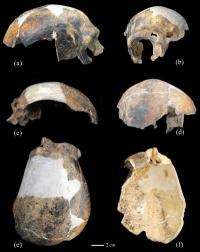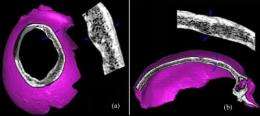New evidence of interhuman aggression and human induced trauma 126,000 years ago

The study of a cranium of an East Asian human from the late Middle Pleistocene age from Maba, China, brings to the fore evidence that interhuman aggression and human induced trauma occurred 126,000 years ago.
The report, published today in the Proceedings of the National Academy of Sciences, suggests that a 14mm ridged, healed lesion with bone depressed inward to the brain resulted from localised blunt force trauma due to an accident or, more probably, interhuman aggression.
"This wound is very similar to what is observed today when someone is struck forcibly with a heavy blunt object. As such it joins a small sample of Ice Age humans with probable evidence of humanly induced trauma, and could possibly be the oldest example of interhuman aggression and human induced trauma documented. Its remodelled, healed condition also indicates the survival of a serious brain injury, a circumstance that is increasingly documented for archaic and modern Homo through the Pleistocene," comments Prof. Lynne Schepartz from the School of Anatomical Sciences at the University of the Witwatersrand, one of the co-authors of the paper.

"It is not possible to assess whether the incident was accidental or intentional, or whether it resulted from a short-term disagreement, or premeditated aggression."
Why is this study important?
"The identification of traumatic lesions in human fossils is of interest for assessing the relative risk of injury to different human groups, the location of trauma, and the behavioural implications," adds Schepartz.
"It also helps us to identify and understand some the earliest forms of interhuman aggression, and the abilities of Pleistocene humans to survive serious injury and post-traumatic disabilities. Maba would have needed social support and help in terms of care and feeding to recover from this wound."

The Maba cranium was discovered with the remains of other mammals in June 1958, in a cave at Lion Rock in Guangdong province, China. The Maba cranium and associated animal bones were unearthed at a depth of 1 metre by farmers removing cave sediments for fertiliser.
The Maba cranium, which is housed in the Institute of Vertebrate Paleontology and Paleoanthropology at the Chinese Academy of Sciences, was analysed visually using stereomicroscopy and a high-resolution industrial CT scanner. This state-of-the-art imaging technology enabled the researchers to investigate the inner structure of the bone to verify that healing had occurred.
Provided by University of the Witwatersrand



















